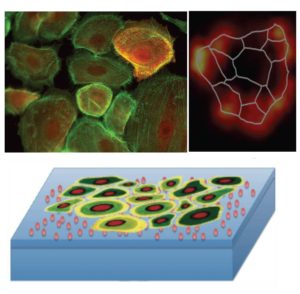
Living cells adapt to their micro-environments by virtue of adhesive interactions with specific substrates. Mechanical properties of the substrate, such as stiffness or thickness, have a profound effect on cell traction or polarization. Using a suitable active gel model for the contractile cell, we couple it to a continuum elastic substrate via focal adhesion bonds. In the presence of contractile activity, the substrate induces spatially inhomogeneous contractile stresses and deformations, with a power law dependence of the total traction forces on cell size. This is in quantitative agreement with recent experiments on cohesive keratinocyte colonies plated on fibronectin coated soft silicon gels. Furthermore our model shows that contractile acto-myosin activity coupled with substrate elasticity induces cell polarization, breaking the cell’s front-rear symmetry. Maximal polarization is observed when the substrate stiffness matches that of the cell, in agreement with recent experiments on stem cells.
Publications:
[1] S. Banerjee and M.C. Marchetti, Substrate rigidity deforms and polarizes active gels, Europhysics Letters, 2011, 96, 28003.
[2] A.F. Mertz, S. Banerjee, Y. Che, G.K. German, Y. Xu, C. Hyland, M.C. Marchetti, V. Horseley and E.R. Dufresne, Scaling of Traction Forces with Size of Cohesive Cell Colonies, to appear in Physical Review Letters.